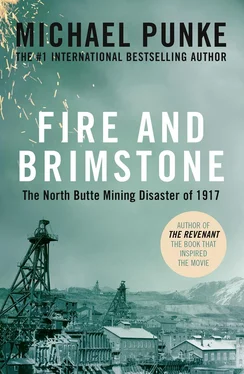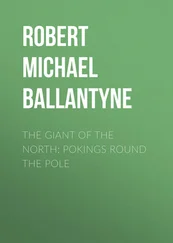Who dug the hole and what if anything they found were never discovered. As Irvine and his men pondered the mystery, a band of hostile Blackfoot Indians approached their position, and the traders beat a quick retreat toward the more hospitable country of the Shoshoni and the Crow. 1
The real discovery of Butte would come as a consequence of the decline in California’s supply of “placer” gold. Placer gold was “poor man’s diggings”—dust and nuggets close to the surface, ready to be scooped up by methods of no greater sophistication than a metal pan or a wooden sluice. As California’s gold industry shifted from placers to more industrialized forms of removal in the mid-1850s, the “forty-niners” began to search for new prospects. They turned inland and by the early 1860s had developed placer strikes in Idaho and Colorado. 2
In 1862, as the Civil War raged back east, wandering argonauts turned up the first substantial gold strike in what is now Montana. The location of the gold was a small rivulet called Grasshopper Creek. Within a year, miners unearthed an even larger deposit about seventy miles away at a site they dubbed “Alder Gulch.” Now the real rush was on. Eighteen months later, ten thousand men were sifting every creek bed between the boomtowns of Bannock and Virginia City. 3
Among the young miners who joined the gold rush to Montana was a skinny, conniving, blindly ambitious twenty-four-year-old named William A. Clark. As much as any man, Clark would rise to shape a critical, rollicking epoch of western history. His origins, though, were humble; he was born of Scotch-Irish parents on a Pennsylvania farm. The Clark family moved to Iowa, where William continued a solid education that included two years of legal study at Iowa Wesleyan College. 4
Clark worked as a schoolteacher in Missouri and apparently fought briefly with the Confederate Army before deciding to seek his fortune in the West. Prospects already were fading by the time the young man reached the Colorado mines in 1862, and after working as a “$2.50 a day laborer,” Clark headed for the new strikes in Montana. With a partner, he staked a claim near Bannock. They built a log cabin and sluices and, after only a year, sold their property for a healthy profit of $2,000 each. For Clark, this initial stake would grow into a fortune of $47 million and make him one of the richest men in the world.
Clark’s early wealth, though, would not come from gold—at least not directly. Like many financial giants of the mining era, Clark’s initial success lay not in the mines—but in the miners. With his $2,000 in profits from sluicing gold, he bought mules and began moving freight between Salt Lake and the Montana boomtowns, carrying shovels, picks, tobacco, and even eggs. His goods, according to Clark, sold for “extraordinarily high prices.” 5With his profits he moved into wholesaling, mail transport, and then banking. By the age of thirty-three he was a millionaire and one of the leading financiers in what had become the Territory of Montana. “[E]verything he touched seemed to turn to gold.” 6
“Turn to copper” might have more accurately described Clark’s career, for it was not the yellow metal, but the red, that would ultimately create the great bulk of his fortune. Nor was it the soon-to-be ghost town of Bannock with which Clark’s name would forever be tied—but Butte.
The first true mining in what was soon to become Butte occurred in the summer of 1864, as Bannock and Virginia City miners began to spread out into untapped areas. Two men, named William Allison and G. O. Humphreys, decided to dig deeper in the shallow pit—the one beside the elk-horn gads—discovered by trader Caleb Irvine eight years earlier. Allison and Humphreys carried dirt from the pit down to Silver Bow Creek to wash it, and in their pans they found gold. They named their site “Baboon Gulch,” though this soon gave way to a more stately appellation reflecting the distinctive nearby hill. “Butte City” was born. (“City” was later dropped.) 7
By 1867, five thousand miners were spread out below the butte and along the meandering Silver Bow Creek. Butte’s naissance as a gold mining camp alloyed the town with characteristics from which it would never separate—not that it wanted to. It was a harsh and dangerous place, where efforts to earn a living came often at the cost of men’s lives. An eastern reporter, as horrified as his modern counterparts by the West’s attachment to firearms, had this to say about the camp: “Every businessman in Butte and every miner is a walking arsenal. He carries a brace or two of pistols in his belt and a Bowie knife in his right boot.” 8
The harsh winters and unsanitary living conditions created a breeding ground for disease, and in mining camps such as Butte “it was a fair estimate that ten percent would die between the months of September and May.” Frozen ground made it difficult to bury the dead, so log stockades were sometimes constructed to protect the bodies from the indignity of consumption by wild animals. 9
With the possibility of death never far removed, miners seized zealously upon the crude opportunities for frontier recreation—centered around the unholy trinity of alcohol, gambling, and prostitutes. Gold might remain elusive for some miners, but the staples of vice seemed to spring up from the soil like weeds. In the vast literature about Butte, no description is repeated more often than “wide open.” The same eastern reporter who blanched at Butte’s walking arsenals had this description of early Butte entertainment: “Bronchos are ridden into public and private houses as it suits their drunken riders. Men, women, negroes, Chinese and Indians daily and nightly congregate in one common assemblage around the gaming tables with which the dissolute, hilarious camp abounds.” 10
If there is exaggeration in the reporter’s description, it most likely concerns the degree of tolerance it implies. Butte would become a melting pot of remarkable ethnic diversity, but “negroes, Chinese and Indians”—while certainly present—were not among those welcomed into the bubbling stew. Butte’s first hanging, for example, took place when a miner named Dan Haffie decided to lynch a Chinese “just for luck.” 11
As in most placer camps, the presence of Butte’s easy gold did not last long. By 1870, Butte’s population had dwindled to 241 souls—98 of whom were Chinese. The high percentage of Chinese indicated the perceived poor quality of the workings. Throughout the West, Chinese often found opportunities in the abandoned claims of less patient miners. 12
Among those few who stayed in Butte, interest by the late 1860s had begun to shift from gold to another precious metal—silver. The presence of silver had long been obvious in Butte. Black “reefs” pushed through the surface in many places, a clear indication of the potential wealth below. Silver, though, required a different type of mining and a different type of miner. Unlike placer gold—which could be scooped up in pure form by a man with a pan—silver required considerable industry. Deep shafts had to be sunk in the rocky ground. Milling was necessary to crush the ore into a more workable form. And it took smelting to separate the silver from crushed ore. Butte’s silver, though plentiful, was notoriously “rebellious,” meaning the silver itself was difficult to extract from the surrounding rock. In short, the production of silver required technology and capital. 13
It was during these early days of Butte’s silver mining that the merchant-banker William A. Clark stepped back into the picture. By the early 1870s, the base of Clark’s burgeoning frontier enterprises was a bank in Deer Lodge, Montana, less than forty miles from Butte. When he visited the remnants of Butte in 1872, his remarkable eye for investment told him that there was great potential in the largely abandoned town. Clark bought four claims outright and would later begin financing the operations of other silver enthusiasts. Demonstrating an attribute that served him well throughout his life, Clark embraced change. With samples from his new Butte properties, he traveled to New York City and enrolled at the renowned Columbia University School of Mines. At age thirty-three, William Clark was about to launch a new career in silver mining. 14
Читать дальше












